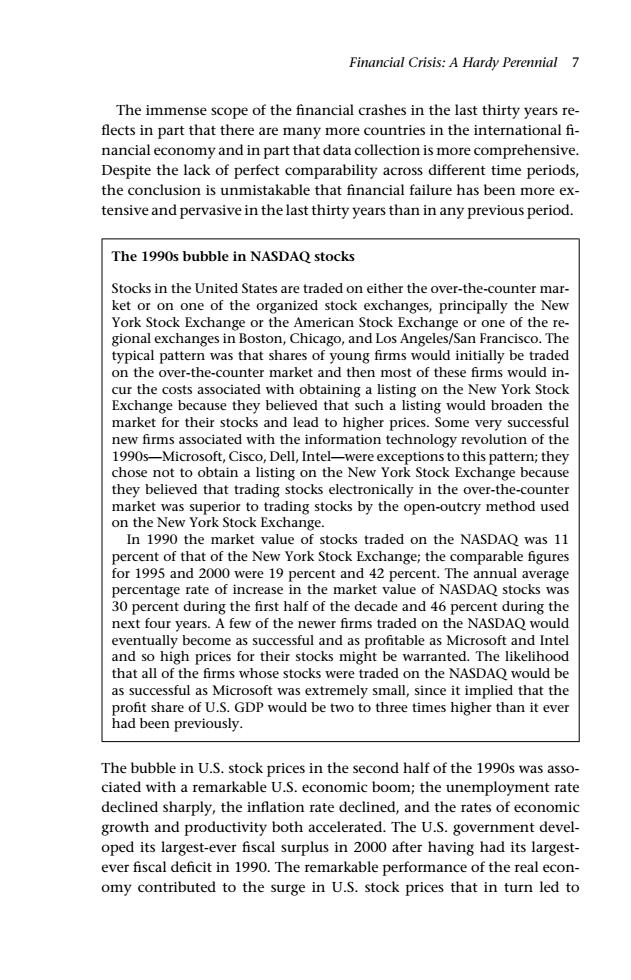正在加载图片...

Financial Crisis:A Hardy Perennial 7 The immense scope of the financial crashes in the last thirty years re- flects in part that there are many more countries in the international fi- nancial economy and in part that data collection is more comprehensive. Despite the lack of perfect comparability across different time periods, the conclusion is unmistakable that financial failure has been more ex tensive and pervasive in the last thirty years than in any previous period. The 1990s bubble in NASDAQ stocks Stocks in the United States are traded on either the over-the-counter mar. ket or on one of the organized stock exchanges,principally the New York Stock Exchange one of the gional exchanges in Boston,Chicago,and Los Angeles/San Francisco.The typical pattern was that shares of young firms would initially be traded on the over-the-counter market and then most of these firms would in rur the costs associated with obtaining a listin on the new york stoch Exchange because they believed that such a listing would broaden the market for their stocks and lead to higher prices.Some very successful new firms ass ociated with the information technology revolution of the 1990s-Microsoft Cisco Dell Intel-we chose not to obtain a listing on the New York Stock Exchange because they believed that trading stocks electronically in the over-the-counter market was perior to trading stocks by the open-o utcry method used on the New York Stock Exchange In 1990 the market value of stocks traded on the NASDAQ was 11 rcent of that of the New York Stock Exchange the comparable figure or 1995 and 2000 were 19 p rcent and 42 n ent.The annual averag ercentage rate of increase in the market value of NASDAQ stocks was 30 percent during the first half of the decade and 46 percent during the next four years.A few of the newer firms traded on the NASDAO would eventually beco sful and as profitable as Microsoft and Inte and so high prices for their stocks might be warranted.The likelihood that all of the firms whose stocks were traded on the NASDAO would be as successful as Microsoft was extremely small,since it implied that the ofit share of U.S.GDP would be two to three times higher than it eve had been previously. The bubble in U.S.stock prices in the second half of the 1990s was asso ciated with a remarkable U.S.economic boom;the unemployment rate declined sharply,the inflation rate declined,and the rates of economic growth and productivity both accelerated.The U.S.government devel. oped its largest-ever fiscal surplus in 2000 after having had its largest- ever fiscal deficit in 1990.The remarkable performance of the real econ omy contributed to the surge in U.S.stock prices that in turn led toc01 JWBK120/Kindleberger February 13, 2008 14:58 Char Count= Financial Crisis: A Hardy Perennial 7 The immense scope of the financial crashes in the last thirty years re- flects in part that there are many more countries in the international fi- nancial economy and in part that data collection is more comprehensive. Despite the lack of perfect comparability across different time periods, the conclusion is unmistakable that financial failure has been more extensive and pervasive in the last thirty years than in any previous period. The 1990s bubble in NASDAQ stocks Stocks in the United States are traded on either the over-the-counter market or on one of the organized stock exchanges, principally the New York Stock Exchange or the American Stock Exchange or one of the regional exchanges in Boston, Chicago, and Los Angeles/San Francisco. The typical pattern was that shares of young firms would initially be traded on the over-the-counter market and then most of these firms would incur the costs associated with obtaining a listing on the New York Stock Exchange because they believed that such a listing would broaden the market for their stocks and lead to higher prices. Some very successful new firms associated with the information technology revolution of the 1990s—Microsoft, Cisco, Dell, Intel—were exceptions to this pattern; they chose not to obtain a listing on the New York Stock Exchange because they believed that trading stocks electronically in the over-the-counter market was superior to trading stocks by the open-outcry method used on the New York Stock Exchange. In 1990 the market value of stocks traded on the NASDAQ was 11 percent of that of the New York Stock Exchange; the comparable figures for 1995 and 2000 were 19 percent and 42 percent. The annual average percentage rate of increase in the market value of NASDAQ stocks was 30 percent during the first half of the decade and 46 percent during the next four years. A few of the newer firms traded on the NASDAQ would eventually become as successful and as profitable as Microsoft and Intel and so high prices for their stocks might be warranted. The likelihood that all of the firms whose stocks were traded on the NASDAQ would be as successful as Microsoft was extremely small, since it implied that the profit share of U.S. GDP would be two to three times higher than it ever had been previously. The bubble in U.S. stock prices in the second half of the 1990s was associated with a remarkable U.S. economic boom; the unemployment rate declined sharply, the inflation rate declined, and the rates of economic growth and productivity both accelerated. The U.S. government developed its largest-ever fiscal surplus in 2000 after having had its largestever fiscal deficit in 1990. The remarkable performance of the real economy contributed to the surge in U.S. stock prices that in turn led to